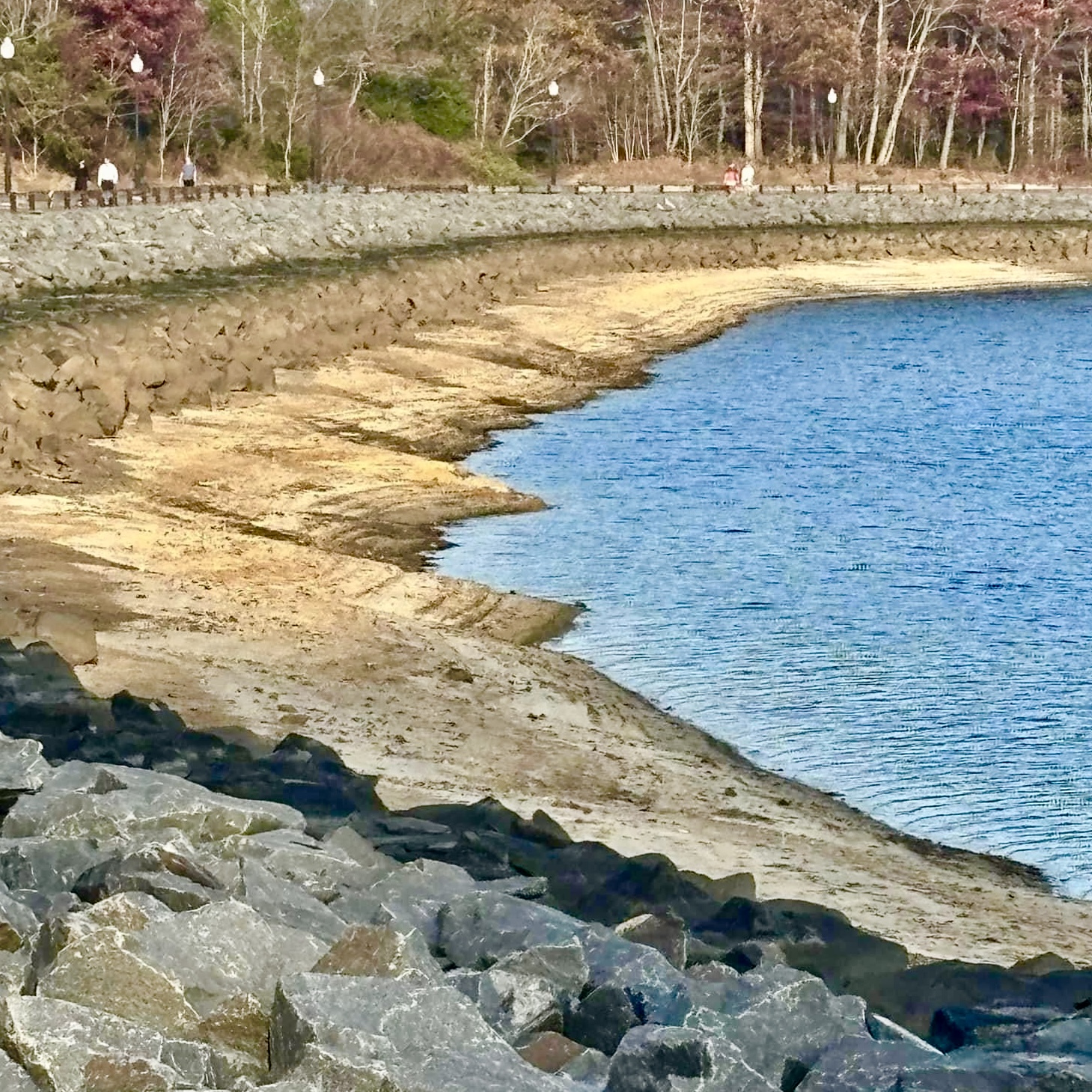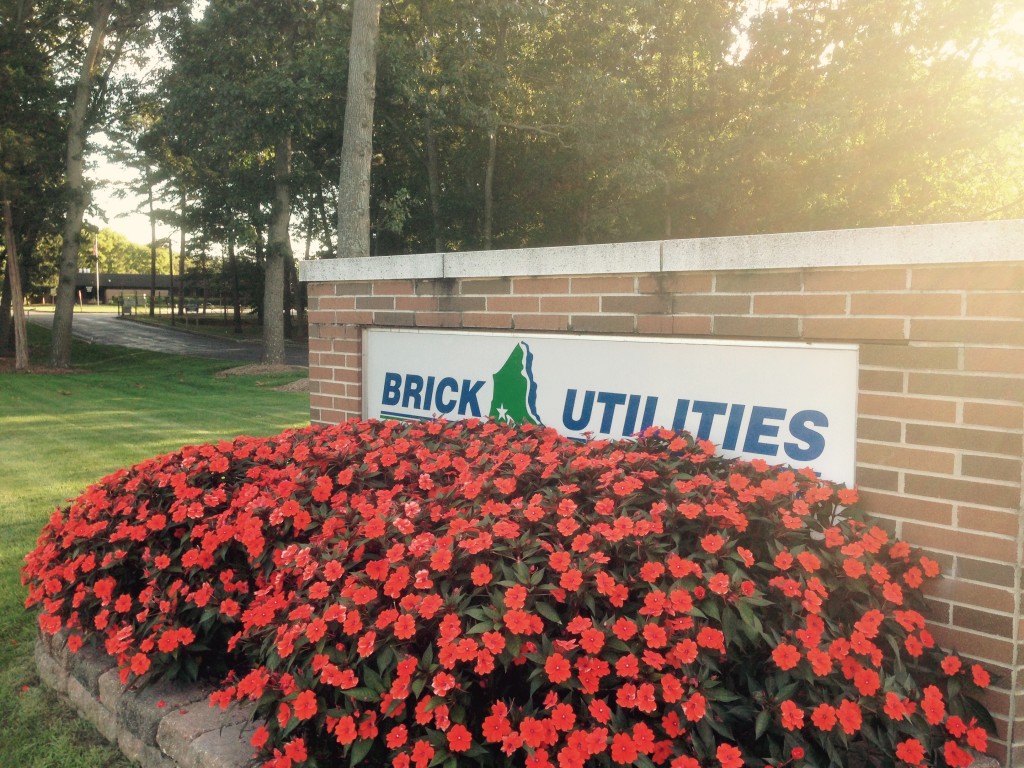
Low water levels at the Brick Reservoir show the sandy bottom of the body of water, Nov. 2024. (Photo: Holly McNabb/ Brick Community Group/ Facebook)
The Brick Reservoir, a sprawling 120-acre source holding more than 850 millions gallons of drinking water, is looking a bit dry in the face of a historic drought in New Jersey. But while photos of the visibly-sandy bottom of the reservoir may rattle the nerves of some residents, officials say the important body of water is fine for now – and will soon undergo an important maintenance project to ensure things stay that way.
Located along Sally Ike Road, the reservoir is built in a former gravel pit that was converted to hold drinking water. It runs to a depth of about 80 feet, and is most familiar to residents who use its picturesque walking trail for a stroll or jog. Recently, however, locals have begun sharing photos of its comparatively low depth on social media.
Going With The Flow
|
|
Those thinking they might one day end up like the distraught character in the Don McLean song who “drove my Chevy to the levy, but the levy was dry,” will be comforted to know that in 2024, technology is working to prevent that scenario from realistically occurring.
“We get water from the Metedeconk River,” said Paul Mummolo, a former township council member who now serves as chairman of the Brick Township Municipal Utilities Authority, which owns and operates the reservoir. “Right behind the reservoir we have wells, so we pull from there.”

Low water levels at the Brick Reservoir show the sandy bottom of the body of water, Nov. 2024. (Photo: Holly McNabb/ Brick Community Group/ Facebook)
A giant network of underground pipes installed over the course of years while the reservoir was being built in the early 2000s connects it to the Metedeconk and Forge Pond – miles away – so it can be refilled when necessary. Refilling the reservoir can be done at times when conditions are favorable, with engineers and technicians looking toward advanced monitoring systems to choose the best time to do so.
“Forge Pond has monitors to tell if salt water intrudes,” Mummolo explained. “If we have good flow at the Metedeconk, we pump it to the reservoir and then it’s gravity-fed back to the plant where it goes through the filtration system.”
Brick has the distinct advantage of being able to pull water directly from the Metedeconk into the treatment system or from the reservoir itself. Notably, during Superstorm Sandy, the ability to be able to source water from the reservoir’s gravity-fed system kept the township’s drinking water flowing despite power losses and damage to infrastructure. Brick was able to avoid service losses and boil-water advisories that were common elsewhere.
When drought conditions occur, salt water tends to creep further west into the Metedeconk, which can lead officials to turn to the reservoir to tap the “reserve” to avoid issues of overuse. During times of abundant fresh water in the river, more can be pumped into the reservoir for use when needed.
Though the low level of the reservoir today may appear to be scary, the township is not at risk of losing its water supply. While conservation efforts are underway to avoid a crisis in the future, “we’re not panicking yet,” said Mummolo.
“Normally it gets low this time of year, but this is exceptional,” he said. “We certainly need rain – but we’re okay, because we have the wells to pull from, and we can pump more.”
Some reservoirs are not as lucky. The Manasquan Reservoir, which provides water to a large portion of Monmouth County, has seen its water level reduced to record lows, with dry areas reaching far out into the man-made lake bed. Brick officials are hoping it doesn’t come to that locally, and are working on a long-term plan to ensure the health of the reservoir for years to come.
Upgrades At a Great Time
Planned for some time, a major maintenance project by the BTMUA that will increase both the capacity and stability of the reservoir has been funded and is out to bid now. While the timing is coincidental with the drought, engineers have been planning the effort for years, taking into account climate change which could bring longer periods of drought as well as unusually rainy stretches of weather.

Low water levels at the Brick Reservoir show the sandy bottom of the body of water, Nov. 2024. (Photo: Holly McNabb/ Brick Community Group/ Facebook)
The project will increase the overall capacity of the reservoir, raising its depth from 80 feet to about 95 feet. It will also stabilize the banks of the body of water below the steep slopes along the edge which now consist of “rip-rap” stones. A fabric-form concrete mattress will be installed to stabilize the banks where the rip-rap is now located, preventing sand from mixing with the water and having to be filtered out.
The project will also remediate the existing sand-covered sloped surfaces. The “mattress” that will be installed will consist of a geotextile structure that will be placed on the side slopes and ledge. Additional upgrades will include the earthwork, sub-grade preparation, placement of stabilization matting, concrete work, and placement of soil erosion measures, plus “incidental restorations,” according to a bid specification sheet.
“We’re going to do that whole area around to allow it to go down a few more feet,” said Mummolo. “We just sent it out to bid, and we’re expecting [the proposals] back in December. Then, hopefully construction will start in the fall of 2025.”
The appearance of the reservoir will not change significantly, but close observers may notice exposed sandy areas, in the future, having been replaced by the concrete-filled fabric mattress.
“The engineers from MUA went and visited other reservoirs that have it – because there are other ways to accomplish the same result – but this seems to be the best way to do it,” said Mummolo.
Drought Concerns Now
The maintenance project will allow the reservoir to not only hold additional water, but ensure that the water is available in times of drought or other periods of time when it is required.
Meanwhile, state officials are busy responding to the concerns posed by the current drought, which on Thursday was declared the longest in state history. In mid-October, following a period of prolonged dry conditions, the Department of Environmental Protection declared a Water Supply Drought Watch. In determining whether to elevate water supply concern status from “watch” to “warning,” state law requires a public hearing to aid DEP’s consideration of whether a potentially critical water supply situation exists across all of New Jersey. That hearing has now been officially scheduled for Nov. 12.
If the DEP determines after the public hearing that a drought warning is necessary, the agency’s commissioner may order any or all of the following:
- Temporary modification of water allocation permits (i.e. passing flow modifications or reservoir releases).
- Development of alternative water supplies where possible.
- Interconnection tests by public water systems.
- Bulk transfers of water between water systems.
- Any modifications or measures deemed appropriate to ensure adequate water supply.
In a statement issued Thursday on the drought, the very concerns being addressed by the BTMUA’s pending maintenance project are a central part of the discussion.
“Recent years have shown a trend of increasingly intense rainfall events followed by periods of little or no rain,” the DEP said. “With the increased uncertainty posed by these weather patterns, it can become challenging for water supply managers to ensure the availability of water resources during dry periods.”
In Brick, two decades after officials had the forethought to create the intricate system that fills and taps the reservoir, its existence is more important than ever.

Advertisement

Police, Fire & Courts
Grand Jury Indicts Point Pleasant Man, Once a Fugitive, for Attempted Murder









